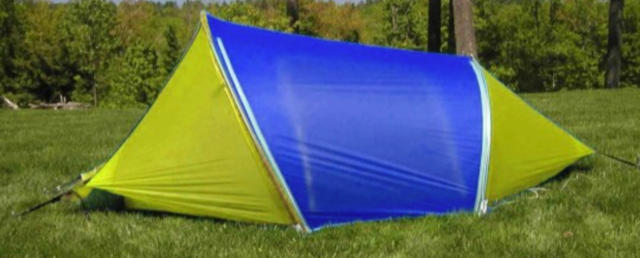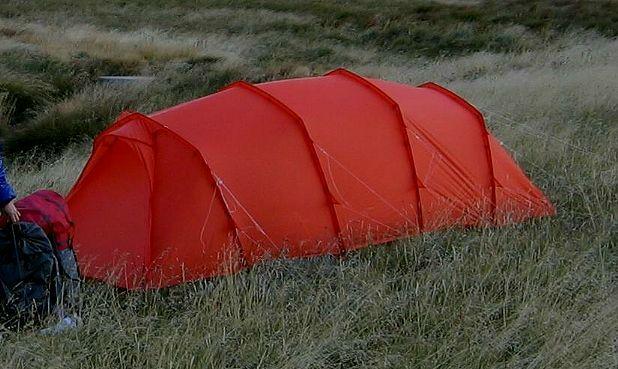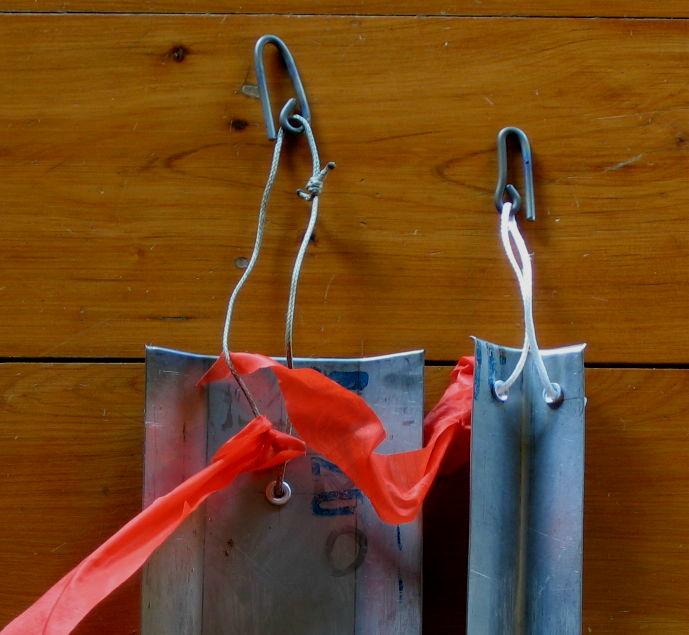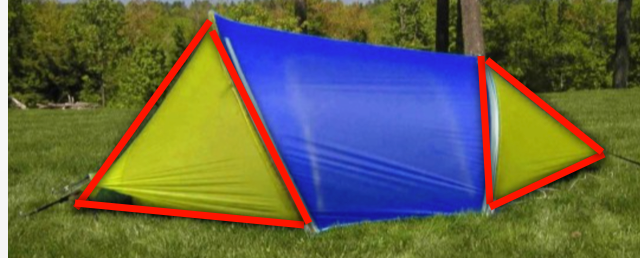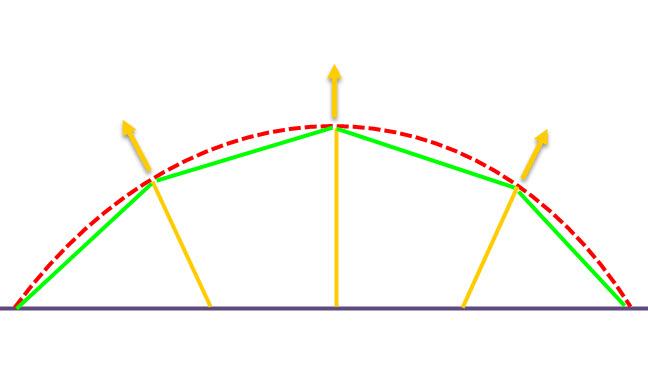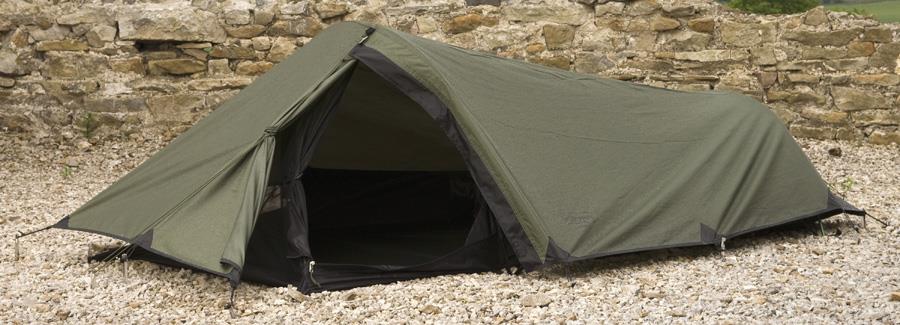Topic
Tunnel tent design help: Purpose of slanting poles?
Forum Posting
A Membership is required to post in the forums. Login or become a member to post in the member forums!
Home › Forums › Gear Forums › Make Your Own Gear › Tunnel tent design help: Purpose of slanting poles?
- This topic has 29 replies, 5 voices, and was last updated 3 years, 8 months ago by
 Geoff Caplan.
Geoff Caplan.
-
AuthorPosts
-
Jun 1, 2021 at 8:14 pm #3716644
Hello friends,
New person here (lurking for a while). It’s a privilege to be able to consult the Wise Men and Women who devote your time to these gentle arts.
I’m thinking up a design for a one-person, one-walled “tunnel” tent. I have several questions, but will try to keep them in separate threads.
The design will borrow aspects of my Warmlite 2 tent and an ancient Slumberjack “bivvy” tent.
Today’s question: what is the function of slanting the poles in the Warmlite tent? The poles on the Slumberjack are vertical, and I would prefer to do mine that way as it is simplest and it keeps the high point closer to the widest point. But I’m wondering if I’m missing some important lesson learned by Warmlite. Does the pronounced slant of the front pole and slight slant of the rear pole give some structural advantage, e.g., aid in tensioning, splitting up the broadside wind exposure more equally between the three planes, or ??? Is it worth the hassle?
In a related question, do you think I should try to introduce a slight catenary cut to the ridge? What about the cone ends?
Please see photos.
Thanks for your help!
*************************************
Background: My priorities are quick pitch, smallish footprint, low wind resistance, and light weight. Head room is not a priority—I need enough to change clothes, or to pee in a bottle. I’ve been a fan of Warmlites since 1980 but I am no longer willing to carry even its modest weight, plus where I backpack, more often than not I have a very hard time finding a place to pitch it, since it is huge. I’ve loved the concept of the Slumberjack, but it is extremely poorly executed. If I can pull it off, my tent will be 48” wide in the front and 30” tall, with a side entrance, large netted windows that will open completely (covered by gusseted flaps that can tie out as awnings), end vents, and a high vent like a Warmlite’s. Poles will stay in the sleeves. Based on my experience with a recently completed tarptent, the tunnel tent will weigh around 29 oz in 1.1 oz silnylon, plus stakes (only two stakes for basic pitch!!). Eventually I’ll make a fitted overtent of silverized mylar to turn this into cool desert shade.

 Jun 1, 2021 at 11:21 pm #3716657
Jun 1, 2021 at 11:21 pm #3716657Don’t know how you guys can live in such cramped quarters, but that is your biz. A few comments:
In estimating weights, suggest getting exact weights of materials and being very precise. This will avoid disappointments with the weight of the outcome.
Not sure why you would want to keep the poles in the sleeves. A bear to pack up.
The most effective construction method I’ve seen on BPL for tunnels is to make a frame over which to tailor the fabric, or use some similar but less expensive fabric with the same bias stretch to determine the shapes of the fabric panels. Flex the poles to the shape they will have after construction, and use them to scribe the frame end panels that are a cross section of the tent. Roger Caffin’s Aussie site has a lot of info about this. You can contact him at [email protected].
Once you have the tunnel tailored on the frame, you can determine if any cat-cut will work. It sounds like you want the lowest weight, so consider DCF, which also may have less need for a cat-cut, since unlike woven fabric, it has almost no bias stretch. I know almost nothing about DCF, so don’t hold me to that.
If you are going to use a superlight woven fabric, there may be some further test results for membrane silpoly posted on the gear forum soon. It is about 0.2 oz/yd2 lighter than the 1.24 oz/yd2 silpoly from RBTR. Given the cuts you want to make in the side of the tunnel, the heavier, but more durable fabric may be best. Even more important, the poly will not sag down on you in the rain like silnylon.
The angles on the poles are called ‘cant,’ as in the poles are ‘canted.’ It helps to keep the tunnel taut, and lowers the force on the stakes in the Warmlite design, so long as the stake points are placed well in front and in back of the tent body; otherwise the stakes would be more likely to pull out from the upward force.
Good luck.
.
Jun 2, 2021 at 7:34 pm #3716888One of the guys (Walker) using my patterns and ideas made a frame like this:
But note that all pole edges are straight, whereas I recommend that the poles be stressed a bit – ie curved. For carbon fibre poles I use a radius of curvature of 2000 mm, not less.
You can have vertical pole planes or tilted (canted). The maths for vertical is simpler, but I prefer the appearance of tilted.

Cheers
Jun 2, 2021 at 8:32 pm #3716899Sam and Roger,
Thanks for promptly writing with your ideas and information.
Roger, so you see no penalty for using simple vertical pole planes? i.e., that I will still be able to tension properly?
You have both anticipated my next question, how to make the mockup for a pattern. I had planned to cut a plywood form from each pre-stressed pole and brace them in place with 2x lumber, so you have confirmed my instinct.
I have read a lot of posts about silpoly vs silnylon. I was planning to use the RBTR 1.1 oz silnylon, which I have used before. It does stretch a lot but I have thought maybe that’s beneficial in this case to keep a tensioned form and compensate for my many mistakes in what will be a somewhat complex form for me to make. I thought maybe the silpoly might stretch so little that it would be more demanding. Is it indeed more demanding of precision in this regard? What do you think?
Sam, while it takes a bit of practice to assemble and disassemble the poles in the sleeves, I much prefer that to having them separate and dealing with insertion in the dark. Takedown and wrapping up is especially easy: I can disassemble and roll up my tarptent in less than a minute.
Jun 2, 2021 at 10:32 pm #3716907no penalty for using simple vertical pole planes?
Not really. They do make the patterns for the middle parts MUCH easier.
Explanation: to fully develop the patterns for the tilted pole versions, you need to deal with elliptic curves, and to ‘invert’ them. Mathematically, that is not possible, which is why elliptic cryptography is so secure. I use some very complex numerical methods to approximate the curves – to within <1 mm. But that is not an analytic solution. Nerd territory: ignore.Very clever trick: each of my pole arches is the same as the others. You only need one arch pattern that way. And all the elbows are the same angle too.
I prefer to use nylon fabric because it has some stretch. The stretch acts as a shock absorber when you are camped on a ridge in an all-night 100 kph storm. Been there a few times. The stretch also handle any slight wobbles in your sewing, even wobbles of a few millimetres.
Yes, the nylon fabric can change dimensions under large temperature swings. When I pitch one of my tunnels, I put a lot of lengthwise tension into the fabric to deal with that. Heavy bungee cord at the lee end (NEVER EVER at the windward end). And I try hard to put the rear end of the tent into the wind. So this means the 2 (or 3) corner anchors are utterly critical. For these I use large dead man anchors in the snow.

The one on the left is titanium with 200 lb Spectra fishing line (double: makes 400 lb). The one on the right is a ‘smaller’ peg for the side guys. The pop-rivets in the holes are NOT optional: they prevent the sharp edge on the titanium from cutting the Spectra cord. Yes, I know it is very hard to cut Spectra, but try 12 hours of a storm hammering and fretting. The red ribbons help to find them in the morning. Being Ti rather than Al means I can stomp them hard to get them out: Ti does not freeze in place the way Al does. There is a BPL article about the pegs somewhere.
Cheers
Jun 3, 2021 at 1:22 pm #3717004Interesting question – I’m trying to think this through for a project of my own.
I’m no engineer, so doubtless Roger will tell me if I’m wrong, but I suspect the canted poles on the Warmlite do have a role and contribute to its legendary performance in the wind.
Here’s an example with a simpler geometry – the classic Phoenix Phortress mountain tent. It makes my point more clearly, I think.
According to veteran gear reviewer Chris Townsend, who has slept in literally hundreds of tents, this was the most bomber shelter he ever used. There could be a hurricane outside and you wouldn’t notice.
The first point that strikes me is that the canted poles reduce the size of the middle panel, which is the most vulnerable on the tent.
The second point is that the A of the poles forms a more stable triangle with the front panels and the front guy than it would if it was vertical. The most efficient design for a truss is an equilateral triangle. The canted pole gets closer to that than a right-angled triangle, which must be significantly weaker.
On the other hand, the shelter you are planning is tiny, so unless it will be exposed to very severe weather it may be fine to go with vertical poles and an easier build. The benefits of the canted poles might be marginal in that scenario?
Jun 3, 2021 at 1:28 pm #3717005Afterthought – looking again at your WarmLite, those are pretty damn close to equilateral triangles – the ideal frame design.
I suspect that’s not a coincidence…
 Jun 3, 2021 at 3:43 pm #3717029
Jun 3, 2021 at 3:43 pm #3717029I did review the Warmlite, and I was NOT impressed. My review is on BPL.
* The sewing on the modern ones was really poor. It was much worse than any sewing I have seen from Asia. The originals may have been better. (Note that the founder is no longer running the company.)
* The whole design is totally dependent on one peg (ONE) at the rear end. If that is not ultra-secure, you are history. There has to be a LOT of tension on it.
* The long span sagged in the wind, badly in the one I had. It is a huge fabric span.
* Inside it is a coffin, with no room for gear or for cooking. No vestibule. Barely room for 2 people in the 2-man version I had.
* Whoever is now making the tent does not understand the design. The door has double zips for absolutely no good reason; they are just extra weight.
* The poles seemed rather fragile to me. OK when the tent is erected, but less so otherwise.
Cheers
Jun 3, 2021 at 6:15 pm #3717048Thank you Geoff and Roger,
Geoff, you may be on to something about canted poles making that middle panel smaller for less wind resistance and equilateral triangles being stronger than right-angled. However, I’m thinking you are also right that in a tiny tent like I am proposing, these factors may not be so consequential, especially since canting a pole only 30″ high won’t do a lot for the middle panel. One reason I’m wanting to make such a small tent is so I don’t have to be so concerned about having the perfect design or execution for strong winds. So I think I’ll go with the vertical poles, taking comfort also in Roger’s opinion. If I were making a larger tent I would reconsider. Thank you both.
Jun 3, 2021 at 6:42 pm #3717053FYI: My Rule of Thumb:
NO fabric span > 1 metre.Cheers
Jun 4, 2021 at 10:26 am #3717141The 1 meter rule makes a lot of sense, and for your classic 2 person, where the weight of the poles can be shared, it’s viable.
But solo tents are much less efficient per person weight-wise, and more compromises have to be made, I think. Using trekking poles for supports helps keep solo shelters a reasonable weight, but the 1m span rule isn’t really achievable with just 2 rigid poles. We have to make do with well-designed guy points. Which can work very well with the right design, provided they can be anchored properly…
Jun 4, 2021 at 10:53 am #3717143I like the look of the canted frames – from a side view, some of these tunnel tents look like arches (aesthetically pleasing), and the canted poles (also arches) look to be angled perpendicular to the fabric surface, minimizing any lateral forces into the poles and equalizing the tension forces in each of the fabric panels. I am sure much more goes into the tent design than that, but even if it is just for the look, I prefer it. That is not to speak on any specifics of a particular tent brand or model, I have no experience with these types of shelters.
 Jun 4, 2021 at 5:53 pm #3717184
Jun 4, 2021 at 5:53 pm #3717184But solo tents are much less efficient per person weight-wise, and more compromises have to be made, I think.
I don’t agree.
If all you are concerned about is scoring UL brownie points, then a roll of Saran Wrap with a reel of thread is your friend.
If surviving a serious storm (winds > 75 kph) so you can continue your trip tomorrow (and the next day) in good condition is a criterion, then ‘compromise’ is NOT your friend.I guess it all depends on the importance you place on survival.
Cheers
PS: a solo version of one of my tunnel tents made for a BPL member weighed 790 g including poles and guy ropes. Is that too much?Jun 4, 2021 at 8:18 pm #3717197Note: 790 gm ~ 25 oz.
But it all depends on the size of the solo tent. That depends on:
– Are you willing to use DCF? Less canopy weight allows more tent. The reluctance arises from the negative reports about durability; although with Tarptent making them, it is hard for me to believe they would make tents out of junk. We also know that woven fabrics with elastic sil coatings have a bias stretch that can absorb blasts of wind better than inelastic materials.. But how much better, given the stronger DCF material?– The size and weight can also be reduced by using canopy walls that slope in ALL directions – unlike a dome or tunnel that collects water on top. But that slope cuts down on inside space, so the design must create convex surfaces on the walls that allow enough space over the head and feet to comfortably sit up. Note the added benefit that the slopes also cut down on wind resistance.
Having considered all of the above, all weight-adding frills must be avoided; i.e., no pitch-locks or added stakes or the like. Also, all the inevitable tiny parts must be designed out , and the rest kept as light as can be. That should bring the size and weight down as much as possible, depending on how much space is desired. For a tent you can comfortably live, cook, and eat in while inside, 25 oz is very good. But as size approaches bivy proportions, much lighter is possible, as the OP notes.
I’ve always been puzzled why it is not obvious that a canted support pole will generate less pressure on a stake in the wind. Also, why some require the full height of a tunnel over the head and feet., even though less height in places can still allow plenty of room to sit up and lie down.
And while Roger’s 100 kph (62mph) worthies are OK, the highest wind velocity that one can reasonably expect to pitch in would seem a better measure for an MYOG tent built for one’s own needs. Especially with a view to how much weight added stakes and guylines can produce. And in a fluke storm, there is usually the option to retreat below timberline to pitch. Maybe not so much in OZ; but that is why “the highest winds that one can reasonably expect to pitch in” is stated above.
On a related note, please note that Jack Stephenson left us a few years ago, his children having already taken on the business. And at present, younger and more distant members of the family continue on. Note that the original tents offered the option of a third pole. Whether the tents have always been sewn as poorly as the one Roger tested has not been established. Yes, I am a little defensive, as Jack gave up aeronautical engineering to introduce completely new approaches, with packs as well as tents, and I respect that even though he could be a little wing-nutty. There’s a lot of that going around these days.
Jun 4, 2021 at 8:37 pm #3717198Randolph J,
I’m a little puzzled why removable poles have to be so fiddly. If the pole sleeves are external, and there is a break at the top of the sleeve, it should be fairly easy to slip the pole in. And speaking of cant, if the edges of the sleeves are hemmed on a cant (as well as hemmed facing out), that also makes for less fiddly.
Also, since the poles are so short, it might be a valuable addition to add a third pole between the end poles. This might help with tent droop.Jun 4, 2021 at 10:19 pm #3717205the highest wind velocity that one can reasonably expect to pitch in would seem a better measure for an MYOG tent built for one’s own needs.
Utterly and totally the WRONG approach (imho).Do not expect that the weather will moderate itself to what your current SUL gear can handle. It is a bit late to find out when you are in the middle of a bad storm in the mountains that your Super Ultra Light has just become Stupid Ultra Light.
The mountains DO NOT CARE.
Cheers
Jun 4, 2021 at 10:28 pm #3717206My question would be, why you would want to make a tunnel tent if you were not expecting to take it out in bad weather conditions? Seems the design is specifically for this in mind, else you’d just grab a BA Copper Spur or some such “fair weather” shelter with way more room.
Jun 4, 2021 at 11:52 pm #3717216Good Question. A better question though is whether you can RELY on having fine weather? We can’t.
As I said somewhere, Xmas in Oz is mid-summer, with all the ‘fine weather’ you might hope for. We had sleet on Boxing Day once. It was not a day walk.
I would not want to be in a Copper Spur in our bad weather.
Cheers
Jun 5, 2021 at 1:44 pm #3717275Hi Roger,
I get it that Oz has different weather. That is why I used the ‘what you might reasonably expect’ language. If I ever go to Oz to trek, will get a Hummer.The tiny tunnel will handle anything without tiny, or slithery feet, and ice storms not heavier than the tiny critters.. That is what Kruschev meant by “we will bury you.” Splat.
PS. Have heard that vipers in Oz are quite lethal. They may even have ‘one-steps.’Jun 5, 2021 at 2:39 pm #3717291Roger’s tunnel tents are a thing of wonder and worthy of the utmost respect. But they are beyond the skills and facilities of most of us. So we look at other options.
But nothing will convince him that anything other than a tunnel can survive any kind of weather :-)
When I said “compromise” I didn’t mean compromise on safety. My design goal is quiet at a min of 30mph and undamaged at a min of 70mph.
I simply meant that with a trekking pole design you have to compromise on the goal of a max 1 meter panel size.
The alternative, as I said, is to go for a design where the large panel is easy to guy. I know from experience that good guys can be very effective.
Jun 5, 2021 at 3:35 pm #3717296Who, me, biased?
:)Guilty as charged m’lud.

Not Hummers for Oz, but Toyota diesel Landcruisers. They are stock/defacto in the ‘bush’. Preferably Series 78. We were exploring by car this trip.
Cheers
Jun 5, 2021 at 3:47 pm #3717298Gentlemen:
Different tents for different folks. Let’s not lose sight of what I started this thread with: a plan to build what is literally, as in Roger’s words, a glorified bivvy tent.
For my money, the best tent is: a) The one that gets carried, and b) The one that gets erected.
I signed up for BPL thinking the name “Moab Randy” would appear as my screen name and somehow my full name came up. But that should tell you something: most of my backpacking now is in deserts and the Sierra. I am not a mountaineer and I don’t snow camp, although severe thunderstorms are a concern. While it would be great to have an affordable, ultralight, ultracompact, ultra-easy-quick-pitch, ultra-ventilated tent that is also bombproof in a blizzard on an alpine ridge, that’s an animal I haven’t seen yet. So I will have fun making something full of compromises but which, if I can pull it off with a reasonably taut form, will not doubt still serve most of my needs quite well. If not, I guess it’s the Copper Spur?
The main reason I carry a tent is because it might rain (or maybe an unseasonable snow in the Sierras), or, occasionally because the mosquitoes are extreme. Otherwise, I’m outside, mosquitoes and wind be damned. Unless I need some otherwise unobtainable shade (for which reason I make my tents of the most opaque material, not one to give a bright, cheery interior). (Anybody know of a source for ultralight aluminized fabric aside from Warmlite?).
Adding a third pole to my tunnel tent would defeat the plan for a side entrance that doubles as a massive window. So I will live with a ridge span of 70”, twice Roger’s recommendation. I’m also not willing to carry the extra pole or to erect it. In my time in the Slumberjack, the span was never a problem. The span of the Warmlite is a problem in strong sidewinds, but more of a nuisance for the intrusion into space, not a threat to the tent’s integrity in the conditions I have used it in. (They do offer a third pole option, as well as internal guys, and, I seem to remember, even might put external guys on if you insist.) The fewer the poles to fiddle with in the dark and wind the better. Yes, three poles is stronger, four poles are stronger yet, but I’m drawing the line at two because of my other priorities.
Quick, easy pitch is a high priority for me. I hike until dark or after. I camp in places where almost no one goes, so there are no established sites. First, that means compact, because literally my most frequent problem is finding a flatish, levelish place large enough to put up a tent without being in the sticker bushes or on top of the cryptogamic soil. Compact is also cozier (sleeping in the Slumberjack is very calming) and also decidedly warmer.
Second, the fewer the stakes to fiddle with, the better. Six or eight guys plus four stakes for corners and maybe more for the ends?—ain’t going to happen. Where I go, as often as not stakes won’t hold without rocks on top and believe it or not, a lot of the time in the desert it’s hard to find rocks, especially ones without creatures residing underneath. My tarptent, even with needing only one stake for the rear, is a pain to put up at six stakes (with side guys).
I’m saving weight and overcoming some of the objections to one-person tunnel tents being unstable in high winds by sacrificing height (30” total height, vs. about 41 for the Warmlite) (plus, I’ll throw in internal guys for the heck of it; because the body of the tent is between the poles, they won’t get in my way). I don’t cook. I’m not sitting around a pot of hot food and playing cards. Once you give up the height, possibilities open up. Of course, I’ll be sorry if an unseasonal blizzard sets in. (Heck, we’ll be lucky to get any snow now days, as the West enters the megadrought.)
Sam—I haven’t seen any other tent for which the poles stay in the sleeves, and maybe it won’t work for most designs, but for my needs, it’s a big improvement. No lost poles, no poles stepped upon, no tent blowing away while assembling separate poles. The biggest PITA with the Warmlite is assembling those long pre-bent poles and stuffing them all the way down those long, tight sleeves and shoving them tightly in place, especially since it can only be done from one side, and I often forget which side that is. On my tarptent, I’ve avoided the problem by leaving the poles in and making my sleeve longer than the pole on one end. That gives enough room to pull the sections apart inside the (baggy) sleeve. Then just fold one section back against the next, and roll up the tent. To assemble, fiddle with the sections to assemble in the sleeve, shove the pole to the closed end of the sleeve, and clip a small buckle under the floor. Works for me and I won’t be going back.
Thank you all for being you.
******************************************************************
In defense of the Warmlite (not that it’s relevant to this thread):
• The erection of the inner layer simultaneously with the outer layer is a HUGE advantage compared to my experience with other tents.
• Never had occasion to notice sag with the inner layer.
• As mentioned, a third pole option is available for you high mountaineers, but I have never felt the need.
• As far as “no vestiblule,” compare the area to other tents—it’s pretty huge. The vestibule area has just been converted to floored area. If you don’t like that, cut a hole in the floor and sew up a bathtub. I’ll take the floored area.
• If you want more space, just get the model 3 (model 2 has large pole in front, small pole in tapered rear; model 3 has large poles front and rear, and the tent does not taper).
• The tent does not “sag” in the wind. Sideways deflection, yes (so maybe order the third pole sleeve if you’re worried), but lengthwise tension has never been a problem, even with nylon fabric. Set the stakes tight, then you can retighten the front two tensioners without leaving the tent.
• The single stake in the rear of the model 2 is, in my opinion, a major strength of the tent. I have never had a problem with that. You only have find or create one good anchor instead of multiple ones. If you’re still worried, daisychain a couple of more stakes behind it. My problem has been with the front—because it has two stakes that have to both be secure and equally tensioned (I’ve added cords to extend the staking range or to tie onto rocks). (A two-stake tent will be the easiest I believe. Anchor the first one in a bomber spot, then swing the tent around until you find a suitable location for the second. Two stakes and you’re in. Tighten one internal tensioner if necessary. Add side guys to improve airflow or wind tension if you like.)
• Yes, they do include a heavier outer zipper on the door, and a lighter one just inside. I think the lighter one may be to channel any water that leaks through the outer zipper; also serves as a backup zipper. If you don’t like it, tell them to leave it out. Or just cut if off.
• I’ve never had a problem with a pole, but I’m not a mountaineer. The poles on the new tents are supplied by tentpoletechnolgies.com, which I know to be heavier than what I have, so they are at least as good as what other people are using.
• I added two superb options: the large side windows, plus a special request that they both have zippers to open completely. Tie out the side flaps for shade and you have flow-through air like a tarp, or two big side doors. A great riverrunning/sea kayaking tent.
• My 1980 version, with the old PU fabric, delaminated after 20 years. I’ve never had a problem with silnylon fabric or a zipper with the 2005 version. So much for fragility. I can’t speak to quality of current manufacture.Jun 5, 2021 at 4:55 pm #3717302Randy makes a very good point: different tents for different places and conditions.
And I understand Randy’s point about the difficulties in getting two pegs in exactly the right positions at the windward end. Been there too.
Well then, we await photos!
Cheers
Jun 5, 2021 at 5:50 pm #3717314Randy
Thanks for getting us back on topic!
You make a highly articulate case for your choice of design – it seems to be right on point.
In my own case I’ve been having an extended dither about height.
Like you I often hike into the dark, though in the alpine, and there’s often the nagging worry about finding a viable pitch. A smaller shelter is lighter, more storm-worthy, more stealthy, cozier, and the footprint is smaller. Also, it looks more like a bivy, and I’m often in areas where bivvying is tolerated but camping is forbidden.
But you do sacrifice ease when it comes to inflating a mattress, changing wet clothes, packing under cover when it’s wet… On short trips this isn’t much of an issue. On longer trips… Still, I follow one woman who has done all kinds of hairy trips around the world in her tiny Nordisk Lofoten and loves it.
I’m a minimalist at heart, and your choices are rather appealing, if I have the guts to go that way.
Jun 5, 2021 at 6:08 pm #3717316Another afterthought. This is the classic “super bivy” around these parts – the Snugpak Ionosphere.
It’s famously bomber, but quite heavy because it’s made of cheap and cheerful materials.
As you can see, despite being only 80cm high, it does have a canted front pole. It’s a front loader, which might have influenced the design and it may simply be that they wanted to widen the entrance – while it would narrow the entrance on a side-loader. But they are a company that knows their stuff, so you might want to consider their choices.
It’s an inner-first design, which I’ve always thought is daft in our UK climate, but it’s a true 4 season shelter that can take a serious beating.
https://www.snugpak.com/ionosphere
And a question. One downside of a smaller tent is that they tend to be prone to condensation. Did you have any issues with your Slumberjack?

-
AuthorPosts
- You must be logged in to reply to this topic.
Forum Posting
A Membership is required to post in the forums. Login or become a member to post in the member forums!
Our Community Posts are Moderated
Backpacking Light community posts are moderated and here to foster helpful and positive discussions about lightweight backpacking. Please be mindful of our values and boundaries and review our Community Guidelines prior to posting.
Get the Newsletter
Gear Research & Discovery Tools
- Browse our curated Gear Shop
- See the latest Gear Deals and Sales
- Our Recommendations
- Search for Gear on Sale with the Gear Finder
- Used Gear Swap
- Member Gear Reviews and BPL Gear Review Articles
- Browse by Gear Type or Brand.


